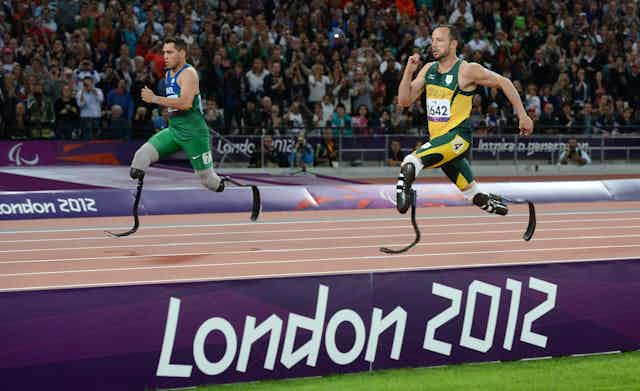In a major upset, Alan Oliveira of Brazil beat Oscar Pistorius to win an extraordinary T43/44 200 metre race today. But did Oliveira have an unfair advantage?
The 20-year-old Brazilian finished ahead of 25-year-old Pistorius in what could only be regarded as a “flying” finish to take the gold medal (you can watch the full race here).
Pistorius’ facial expression, body language and post-race interview showed his displeasure at the loss.
At the heart of Pistorius’ concerns was the fact Oliveira and the American Blake Leeper had an unfair advantage through the lengthening of their prostheses - the blades the three athletes ran on in the race.
In a post-race interview, Pistorius went on to say:
We’re not racing a fair race here. The regulations say that you can make yourself unbelievably high. I think Alan’s an unbelievable athlete but I don’t think you can come from 8m behind to win.
Can of worms
The technicalities of prostheses length are best left to the International Paralympic Committee (IPC) and others to argue and the legality of their use in the race could be tested through protest if Pistorius’ concerns are within the realms of race considerations.
But whether Pistorius realises it or not, his post-race concerns about fairness have opened a can of worms for the IPC and the International Olympic Committee (IOC), which have been raised in academic circles since before the Beijing 2008 Olympic and Paralympic Games.

As other articles have recently examined on The Conversation, the whole question of fairness and having a level playing field for Paralympic athletes is a complex issue that is a combination of the classification system, the cyborgs of technology, and the relative imbalance between access to sport science and technology by developed and developing nations.
These issues have created considerable tension within the international Paralympic sporting movement and have raised significant issues about the role of advances in technology and athletes with disabilities.
The history of the Paralympic movement has been dominated by medicalised notions of disability.
While there is now a greater representation of people with disability within international Paralympic sport administration, efforts to “normalise” the disabled body remain and have been raised to extraordinary lengths.
These efforts now see the Paralympics as an international showcase for the latest breakthroughs in medicine, sport science and sport’s equivalent of the technological “arms and leg race”.
In an Olympic context, the “cyborg factor” - the technology-body interface - raises significant issues with respect to whether technology “normalises” the disabled body, restoring the body within normative ranges of human ability, or creates an unfair advantage by extending performance beyond normal function of what would have been an athlete’s bodily potential.
Where to now?
Pistorius has asked, in a very public way, whether Oliveira and Leeper’s actions of the lengthening the blade length create an advantage beyond what should be regarded as fair?
Apart from the notions of fairness and equality of sport performance, the question also raises further questions as to the nature and positioning of the Paralympic games as the pinnacle event for disability sport, and the involvement of athletes with disabilities who use prostheses in non-disabled sporting contests, including the Olympic and Commonwealth Games.
The answer to Pistorius’ question will be hotly debated in the press, by the IPC and the IOC over the coming hours, days, weeks, months and years as we move towards the Rio 2016 Olympic and Paralympic Games.
Further reading:
Pistorius’ loss to Oliveira fuels the ‘disruptive technology’ debate

